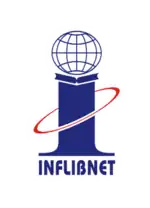| Information and Library Network Centre | |
|---|---|
 | |
| 23°11′18″N 72°38′00″E / 23.18833°N 72.63333°E | |
| Location | India |
| Type | Repository, Networking Universities |
| Established | March 1991 |
| Other information | |
| Website | www |
INFLIBNET Centre (Information and Library Network Centre) is an Inter-University Centre of the University Grants Commission (India) under the Ministry of Education (India). The organisation promotes and facilitates libraries and information resources for Indian further education. Its premises are in Gandhinagar, Gujarat.[1]
Shodhganga, the digital repository of theses and dissertations submitted to universities in India is maintained by INFLIBNET Centre. INFLIBNET also performed an important role as an online learning resources by HRD Ministry during COVID-19 lockdown in India.[2][3]
History
INFLIBNET is a major National Programme initiated by the University Grants Commission (India) in March 1991 as a project under the Inter-University Centre for Astronomy and Astrophysics (IUCAA). It became an independent Inter-University Centre in June 1996. INFLIBNET runs a nationwide high speed data network connecting university libraries and other information centres.[4]
INFLIBNET is involved in modernizing university libraries in India using the state-of-art technologies for the optimum utilisation of information. In 2022, University Grants Commission (India) launched an initiative with the Information and Library Network (INFLIBNET) Centre to assist research scholars and their supervisors in conducting their research.[5]
Activities
The Shodhganga portal of Inflibnet Centre displays the achievement of the competing universities with a detailed index of number of theses contributed by several departments of study. Calcutta University, Savitribai Phule Pune University and Aligarh Muslim University (AMU) have become largest contributors of theses to the Shodhganga portal of Inflibnet Centre.[6]
The Centre leads projects for the development of library services in Indian universities. These have included:
- Financial support for automation of university libraries
- Development of a database of resources in libraries in India
- Development of a library management application named SOUL (Software for University Libraries)[7]
- UGC-Infonet, an Internet connectivity programme
Open access initiatives include:
- OJAS, a platform for faculty and researchers in universities to host journals[8]
- Shodhganga, a digital repository of theses and dissertations by research scholars in universities in India[9]
- Shodhgangotri, a digital repository of synopses of research topics submitted to universities in India[10]
- IR@INFLBNET, an repository of papers
- Creation of R&D facilities and working groups to study and contribute to the open source movement
- Maintenance of a database of scientists, researchers and faculty members at academic institutions and organisations involved in teaching and research in India
- Bibliometric and scientometric studies
- e-PG Pathshala, a gateway to Postgraduate courses
- Training courses in Library Management and Information and Communication Technology (ICT)
Publications
INFLIBNET publishes a quarterly newsletter and annual report which are distributed to the academic community across the country.
See also
References
- ↑ "INFLIBNET Shodhganga: Access 1.35 Lakh Theses Online Now". NDTV.
- ↑ "10 online learning resources by HRD Ministry you can use during Coronavirus lockdown". India Today.
- ↑ "10 HRD-UGC Initiatives For Online Learning". NDTV.
- ↑ "10 Varsity eyes access to digital libraries". The Telegraph (India).
- ↑ "UGC launches Shodh Chakra to help scholars, guides in research work". Hindustan Times.
- ↑ "Calcutta, Pune, AMU Varsities Top Theses Contributors To Shodhganga Portal". NDTV.
- ↑ Home page of SOUL
- ↑ Home page of Open Journal Access System
- ↑ Home page of ShodhGanga
- ↑ Home page of ShodhGangotri
External links
Further reading
- Shahaji Shankar Waghmode. "Role of INFLIBNET in Growth and Development of Higher Education in India" (PDF). e-LiS. Retrieved 8 October 2016.